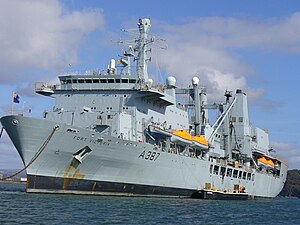Fort_Victoria-class_replenishment_oiler
Fort Victoria-class replenishment oiler
Class of replenishment oiler of the Royal Fleet Auxiliary
The Fort Victoria or Fort II class is a class of replenishment oiler of the Royal Fleet Auxiliary, a role that combines the missions of a tanker and stores supply ship.[3] As such they are designated auxiliary oiler replenisher (AOR). They are tasked with providing ammunition, fuel, food and other supplies to Royal Navy vessels around the world. There were two ships in the class, Fort Victoria and Fort George; the latter being taken out of service and despatched for scrapping at a Turkish breakers as a consequence of budgetary cutbacks.
This article needs additional citations for verification. (June 2008) |
